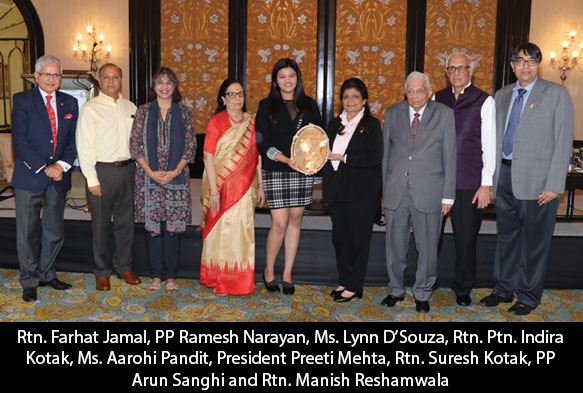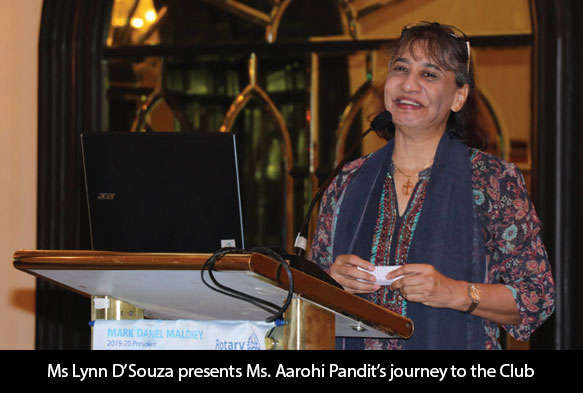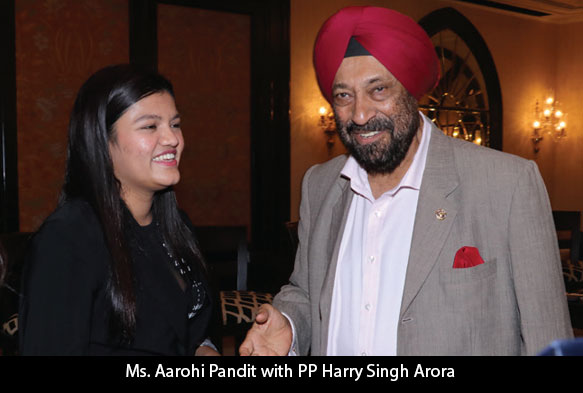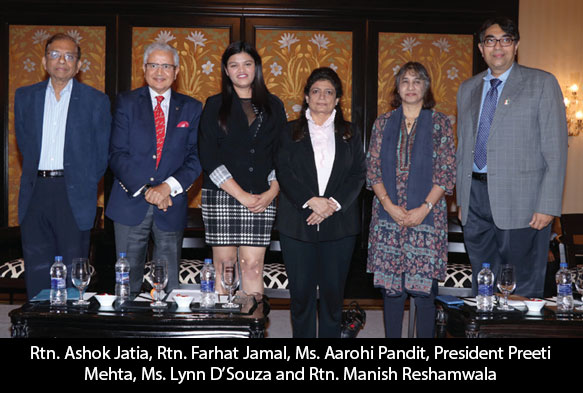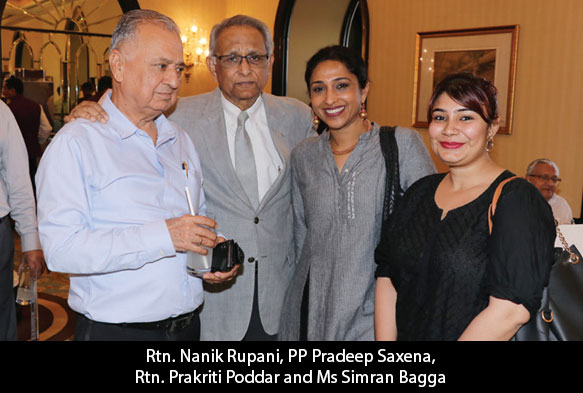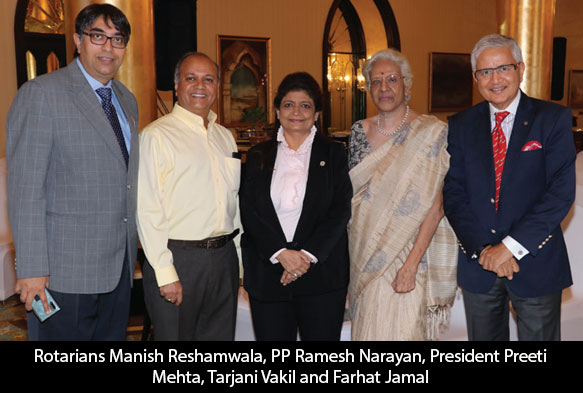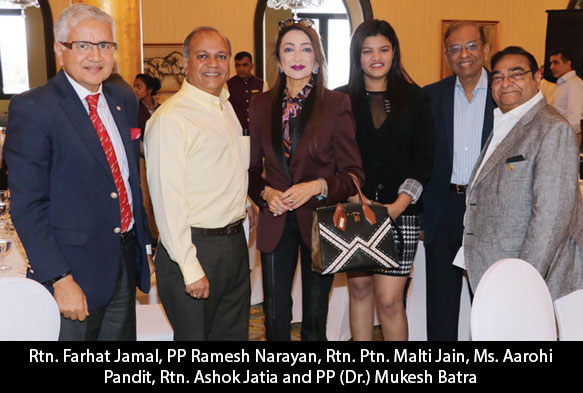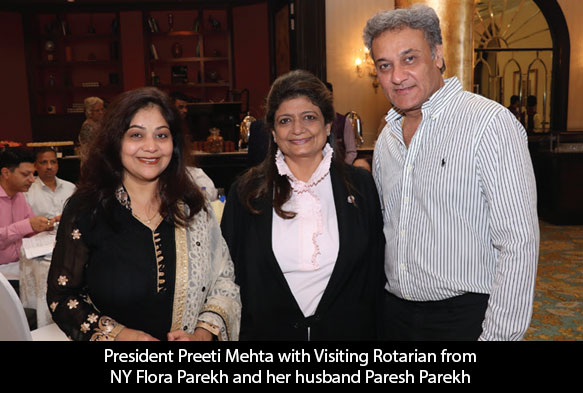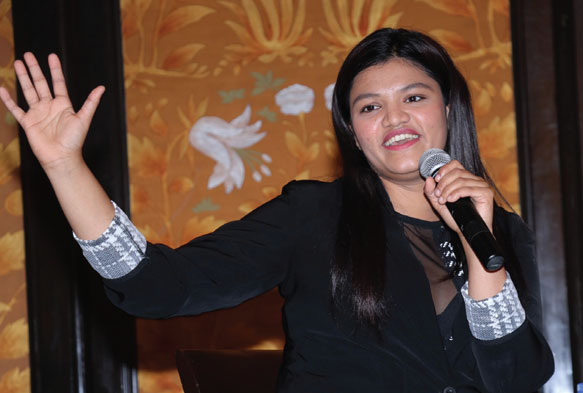
Flying High
Captain Aarohi Pandit, a 23-year-old pilot from Mumbai, became the world’s first woman to cross the Atlantic Ocean solo in a Light Sports Aircraft (LSA) last year. She spoke of her experiences at the Rotary meeting last Tuesday
Rotarians gave a rousing welcome to the 23-year-old pilot Captain Aarohi Pandit who smashed multiple world records as she flew across the Atlantic Ocean in the light sports aircraft Mahi. Along with her was Lynn D’Souza (head of Social Access, a not-for-profit communications firm which organised the expedition); if Capt. Aarohi was the face of the expedition, Lynn was the soul of this dream and who conceived this expedition.
In conversation with Lynn D’Souza, Capt. Aarohi Pandit took the Rotarians through her journey. Lynn shared some of the breathtaking pictures from the record-breaking expedition which were astounding, thrilling and frightening. Capt. Aarohi flew 6000 ft. upon the Pacific Ocean alone, trained in Iceland and it was an experience worth noting.
“Capt. Aarohi is part of the We! Women Empower Expedition, which is an attempt to be the first all-women team in the world to circumnavigate the world in a Moto rider for a lightweight sports aircraft, it is almost like a scooter in the sky,” said Lynn.
Lynn then shared some of the details of the expedition. “She left Patiala, India on July 31st where they had been trained for two months by the Patiala Aviation Club. The Punjab government took care of them free of cost and the Maharani of Patiala flagged them down. From there they, Capt Aarohi and Keithair Misquitta came down and exited India from Bhuj to Karachi and, again, the very first light sports aircraft – Indian registration VT to land in Karachi since Independence, by two girls!”
They flew up to Scotland – that was a record in itself. Then came a part of flying over the oceans in the northern latitudes where Capt. Aarohi flew alone, without any military training, for her love of flying. She did the Greenland Icecap, a big achievement because there is no search and rescue available on the Icecap. So she was flying at 80,000 feet, so if anything had happened to her, that would have been the end of it. Then she entered Canada, and flew all the way to Alaska. There were 54 stops and finally they ended up in far-east Russia at which point the Pakistan Air force was closed to them; Iran was closed too. So they were talking to the Russians to do something but in the interest of safety, brought Aarohi and the plane back. The expedition will now be completed in the summer.
Lynn: What made you undertake this mammoth task?
Capt. Aarohi: Flying is love and passion and I don’t take it as a job or workload, I take it as freedom. So when you brought it to me, I was excited to fly in a twoseater plane. With my co-pilot Keithair Misquitta, back then, it was exciting to have the opportunity.
What made you like flying?
My dad is in a tours business, he takes school and college trips and industrial visits. I have been traveling with him since I was four-years-old, right up till the age of 16. I was at Cochin airport, taking a flight from Kochi to Bombay and it was a connecting flight from Cochin- Bombay-London. Back then, we did not have women commandos in Air India or any other airlines for that matter. I remember seeing a female co-pilot, the uniform was so sparkly back then, the thing that caught my attention was that she got all the attention in the room because everyone was looking at her – nobody was looking here and there; people were following her instructions – that is what attracted me. I decided that this is the only thing I want to do.
What did you feel flying over the Atlantic and Pacific? It must have been tough – what were your thoughts
and emotions as you were all alone?
My first time over the Atlantic Ocean was my first time ever over an Ocean. I did not think whether it was going to be good or bad, I just prepared my flight plan like I did for every other flight. The only thing I did was wake up every two hours the night before to check the weather and prepare myself. But I did not think about emergencies. The first thing I saw on my first flight was a beautiful rainbow over the Atlantic Ocean. So the start was very good but my flight was five hours 49 minutes long, from Scotland to Iceland. The Atlantic is so massive that the weather changes every 30 to 40 minutes. I did get into bad weather, I did get into dark clouds, there was turbulence which was pushing my plane up and down and left and right, I spilled my coffee, my food was going everywhere. But it was worth it.
Aarohi, you have seen climate change first-hand; you have flown in July 2018 and July 2019, you have flown in winter as well as summer and you have seen the ice melting, haven’t you?
Yes, I did. So I won’t say a lot about it because I haven’t seen the entire world but yes, I believe my generation is the last generation who can do something about it. If we take it for granted, there is no turning back. And I think nobody has suffered climate change worse than us because everywhere we went we faced early summers, early winters, we couldn’t fly for weeks. My plane was such a small soul, we still pushed her limits. But I have seen climate change in a nook, I saw a polar bear right in the middle of the ocean floating on a little bit of ice and who had to be rescued later.
I have seen climate change in a nook, I saw a polar bear right in the middle of the ocean floating on a little bit of ice and who had to be rescued later.
The circumnavigation that we planned to do in eight months, took us two years because of climate change. There were forest fires in Canada and we had to reroute her, forest fires in Russia and we had to turn her back. It was disastrous. Tell us about the people you met.
I made a lot of friends all over the world. I was in Kulusuk Island in Greenland with a population of 200 and I am pretty sure I know all of them because I was there for a pretty long time due to the weather. They gave me a nickname, the Indian Princess. Usually, when we fly we are in contact with the ATC tower and instead of calling my name they used to call me Indian Princess because he could not say my name. So yes the people were sweet and amazing. I have had free pickups and free food.
So, Aarohi, can you tell us the difference between the aviation in India and globally?
The major difference is that compared to India, there is much more freedom globally. Like, as basic as I hold two licenses: one is the commercial license and the other is a sporting license. But according to Indian rules I cannot fly a commercial and a light on micro light at the same time. I have to give a limited amount of break. Whereas in the other countries that I have flown, there is a lot of freedom, I think they get their flying license before their driving license, because I have met so many pilots. But India is much safer because we have laws. So I think we hould have much more freedom so that more and more people can get into aviation.
Rotarians ask
Rotarians ask 22 countries, 52 stops, where do you see yourself in five years?
To be honest, I don’t even know about five months from now but for sure flying somewhere up in the air and doing something different.
Who took care of the finances?
It was taken care by WE expedition. In phase 1, we had sponsors like Colors network and Mahindra had sponsored Aarohi’s stay. In phase 2, we did not have sponsors so we had to fund it on our own. We also had a lot of donors who came forward with safety equipment or some other work. But for phase 3, which is return from Russia to India, we are looking for benevolent people who want to contribute or support. We don’t have a title sponsor for that.
You have travelled to so many countries, how do you handle the food?
I guess I was an animal because I ate whatever I got. I had duck in Iran, they call it bakhtyar kebab and I ate it because I thought it was chicken. And potatoes, you get potatoes everywhere. My nickname is Aaloo.

